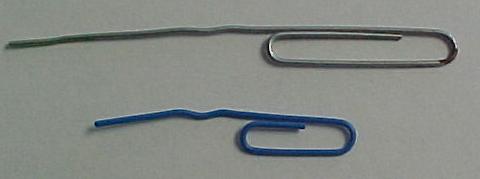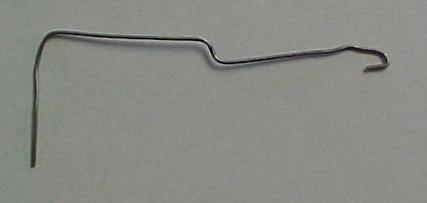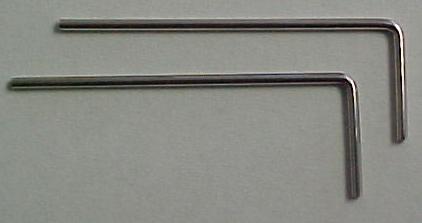The analog CD extraction device is probably the most common tool created from a paper clip (see figure 1's red circle). Most don't realize that when they take the time to make an analog CD extraction device they have also made a make-shift ATX power switch (see figure 1's blue circle). This is a brief description of some useful analog CD extraction device's and other paper clip tools.

figure 1: analog CD extraction device w/ make-shift ATX power switch
Over the years I've created some interesting and some not so interesting variations of the analog CD extraction device. As one can see in figure 2 this is the "Travel analog CD extraction device w/o the make-shift ATX power switch." It lacks the power switch portion of the normal analog CD extraction device due to it's non conductive blue external coating. The blue coating does serve a travel purpose and that is it makes this paper clip stand out over others. I really hate it when I get my analog CD extraction device confused with other tech's analog CD extraction device.
figure 2: travel analog CD extraction device w/o the make-shift ATX power switch
The next figure is a paper clip tool that has nothing to do with CD extraction at all. This is a paper clip tool that was meticulously created with a pair of needle-nose pliers to make the monotonous tasks of bending pins on the Nintendo 72-pin cartridge connector pass quickly and smooth.

figure 3: NES cartridge connector pin bender
Another paper clip tool I made to hold IDE cables in place. In an ideal world, IDE cables are out of the way to allow for better air flow in a computer case. Sometimes that's easier said than done, but this can keep folded up IDE cables well...folded up. It's ten times manlier than using a bobby pin.

figure 4: IDE cable holder
Figure 5 is neither something I made nor a paper clip, but I thought it would be interesting to include a real manufactured analog CD extraction device. This particular model comes with some CD/DVD drives, and I have found in most cases they are too big to be used in any other CD/DVD drive other than the ones that come with. Essentially, they are useless for most analog CD extraction needs, and on top of that they aren't very good ATX power switches either.

figure 5: manufactured analog CD extraction device
These are the paper clip tools I use; I'm sure other people have come up with other/better paper clip tools. I'd love to hear about them so feel free to leave a comment and preferably a picture.
6 comments:
You can make a handy dandy lock pick set with a pair of paperclips.
Usually, when making lockpicks it is best to use large paperclips so as to avoid the bending of your tools when holding cylindars in place.
To effectively pick a lock you will need to picks, one that is shaped just like an analog CD extractor and another simlarly shaped but with a small curve in the end. Unfortunately, I don't have pictures.
I sort of felt like it was necessary for me to review your blog Mr, Pryor. Your blog is awsome, very good stuff man! I admire your work. I remember the days we spent calculating names for shit in the warehouse until that one day when there was no more Rubiks Cubes and no more chess permitted. Those were some funny times.
Rabenstrange,
Luckly, I have pictures of what you're talking about. Well, I don't have pictures, but I have a link to some.
Felix,
It is most necessary that you review my blog. Your oppinion is valued. By the way, like my avatar? I knew, of all people, you would.
Want to know what we use when we can't find a blade at work?
A handy dandy paper clip; it turns into a splendid box cutter when used properly, but I never told you since its just one of those things we do at work.... heh.
Your Travel Analog CD Extraction Device can also be used as a makeshift ATX power switch by using wire cutters to gently cut through and peel away the plastic identifier coating.
Post a Comment